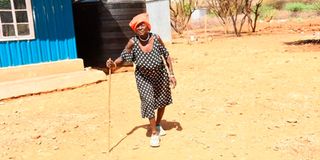State blamed as mathenge weed wreaks more havoc

Kabon Ngochila, 89, struggles to walk as painful wound in her eye and right leg worsens every day. She was pricked by the mathenge weed while working on her farm five years ago.
What you need to know:
- The weed was introduced in Kenya in the 1980s by the government and the Food and Agriculture Organization.
- It was meant to address desertification and help reclaim barren lands into productive zones.
Kabon Ngochila, 89, sits outside her home in Silinyo village, Marigat, Baringo County, with flies converging on her right leg.
The elderly widow walks with difficulty since she was pricked by Prosopis juliflora (mathenge) thorns five years ago.
She was pricked in the leg and eye. While the leg showed signs of healing, the eye was badly injured and no longer functions.
“She was tending to her goats when she accidentally got pricked by the plant. The wound began spreading and she could not move for a whole year,” said Felix, Kabon’s grandchild.
Felix curses the heavens as he speaks of the disastrous effects that the plant has had on the lives of locals and the economy of the region.
The plant, he said, has done more harm than good to the pastoral community, whose lives are threatened, animals killed and environment affected.
The weed, native to Mexico, South America and the Caribbean, was introduced in Kenya in the 1980s by the government and the Food and Agriculture Organization. It was meant to address desertification and help reclaim barren lands into productive zones. But after about two decades, it started becoming invasive and poisonous to plants, animals and the environment.
It grew rapidly, spreading throughout fields, invading grazing land and choking indigenous plants. It led to the loss of pasture land and livestock, and blocked roads and rivers.
And to make matters worse, it produces thorns that are poisonous and deadly to humans, while animals that feed on it lose their teeth before starving to death.
Communities in Baringo, Laikipia, Samburu, West Pokot, Marsabit and other counties are unable to control the invasive and annoying plant. The government, environmentalists and conservationists —who have for years discouraged Kenyans from making charcoal as it destroys forests and vegetation covers, exposing land to soil erosion — started encouraging locals to make charcoal from the plant.
But there is a problem. Communities say laws and bylaws imposed by the government are hampering the fight against the weed.
Ilchamus Community Charcoal Burning Association Chairman Joel Lekurito says the deal collapsed when the government announced a moratorium on charcoal making in all Kenyan forests two years ago.
Clearing the weed
“Before the ban, with our over 60 groups, we were already making money from the sale of quality charcoal from the mathenge tree,” he said.
“We would like the government to reconsider Prosopis for charcoal burning because it is the only method we can use to control its evolution.”
He said locals have renewed push to get the government to look for methods of clearing the weed, citing its harmful effects on the community.
“The largely pastoral community would wish to turn to farming, growing pasture, sugarcane and fruits such as bananas and mangoes, but the trees have taken over our farms and the government has banned charcoal, so we are in distress,” Mr Lekurito said.
The Nation caught up with Mr John Napirr clearing five acres of land to plant vegetables. He said the weed is now blocking the rivers feeding lakes Baringo, Bogoria and Lake 94 and causing more disaster. He observed that the shrub sprouts quickly even after clearing.
Ministry of Environment and Forestry Principal Secretary Chris Kiptoo recently said the government was considering allowing communities troubled by the weed to cut it for charcoal.
Ilchamus MCA Joseph Leparsalaach blamed the weed for the heavy flooding that often affects the region. He said the weed blocks pathways and diverts waterways, leading to flooding.
The weed also contributes to the deaths of flamingos and other birds in Lake Bogoria.
Mr Leparsalaach, however, regretted that the government had failed to take any action to save the community from the plant though a court had directed on the steps to take.
In a judgment issued by Justice M.A. Ang’awa in 2008, the court observed that the mathenge weed had caused more harm than good to the environment and should be eradicated or properly managed.
Thomas Letangule, the lawyer who filed the case on behalf of the Ilchamius community, said the government has ignored all court orders.
“The weed has become more dangerous now than ever before yet the government has decided to disregard the court orders,” he said.






